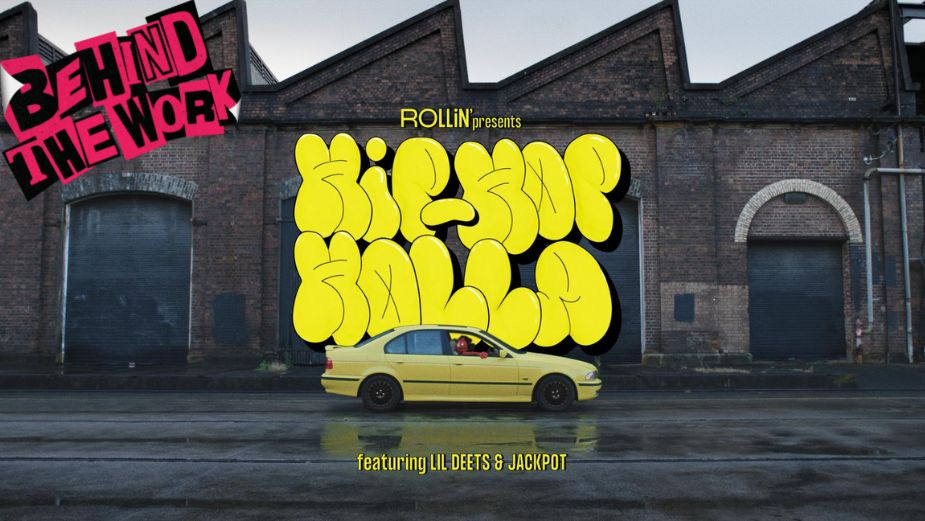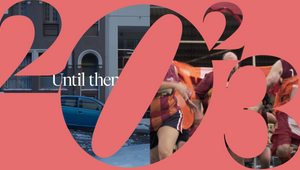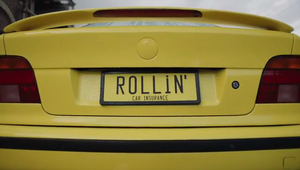
How Puppets Took ROLLIN' Through Hip-Hop History

When, in 2021, Larry the puppet spun his way onto our screens, boasting, in the voice of Humpty Hump, that he was going to “ruin the image and the style that [we’re] used to”, he meant it. And so did ROLLIN', the flexible car insurance brand he represented.
The instantly iconic ad created an image of a chilled-out, innovative, and irreverent company, one attuned to consumer demands and the blissed-out good time feel of old school tunes. For that, we have Bear Meets Eagle on Fire and Revolver to thank. In 2022, the creative agency and production company re-teamed for a follow-up campaign. Here, two puppets (Lil’ Deets and Jackpot) celebrate the history of the genre which has become ROLLIN's signature style.
The ads are instantly attention-grabbing - but why? What is it about the spectacle of two fuzzy puppets celebrating the culture which matches ROLLIN' so perfectly? How do you design puppets like that? How do you operate them? How do you find their voices? And where does one find the strange creative spark to tie all these disparate elements together?
To find out, LBB’s Delmar Terblanche spoke with Micah Walker, CEO and founder of Bear Meets Eagle on Fire, and Anna Mannix, executive producer at Revolver, about how this delightful, distinctive, and daring campaign was put together.
LBB> What was the initial client brief from ROLLIN'? How did they hope to highlight the benefits of their flexible car insurance via this unorthodox series of ads?
Micah> The brief was (and still is) to create engaging social content that’s an extension of our brand world. So, the role for this particular social series wasn’t to push the flexible car insurance message - there are other pieces of communication within the overall plan designed to do that.
LBB> The work builds on the previous ad series which featured Larry rapping along to Digital Underground track Humpty Dance - what brand associations are you hoping to tap into via this continued use of both puppetry and classic hip-hop?
Micah> Creating a unique voice and identity isn’t just about fonts, colours and brand books, it's about creating a world that you can continue to build on over time. So yes, there’s a specific and conscious filter we apply to everything ROLLIN' does, and that includes hip-hop and irreverent characters.
Classic hip-hop made a lot of sense to us in the early stages of creating the brand because it fit conceptually with the theme of making something fresh out of something familiar, it wasn’t an overused genre (at least in Australia), and maybe more intuitively, it just felt like a great fit with the spirit we wanted to be a part of the brand. The response in launching with a freestyling puppet singing ‘The Humpty Dance’ by the Digital Underground just confirmed that.
LBB> Tell us about the puppets. What was behind the decision to use those Jim Henson-like puppets? And how were they designed?
Micah> We felt like there was a unique brand trait in taking ‘old school things’ and making them fresh again. That’s what ROLLIN' is doing for traditional car insurance and we liked having that inform part of our brand world. We don’t expect consumers to literally play that back, but it does give us a distinctive filter when coming up with ideas.
As for the puppets, we’ve been fortunate to collaborate with some very talented character & puppet creators and puppeteers at MEG Fx for Lil’ Deets and Jackpot, and ODD Studio for Larry in our brand launch spot - both based in Sydney.
Anna> Micah and his team had an incredibly strong vision of what these puppets would look like and we agreed the look of them with the juxtaposition of their dialogue and actions worked well. The director Mike Long then actually designed them in collaboration with the agency and the model makers here in Sydney, MEG. There were certain elements of them that were altered to fit the action – for instance Lil Deets had to have particularly long arms to reach the steering wheel & Jackpots body had to be a certain height and width to ensure it could be seen and read from the drivers side – and not get lost in the frame.
LBB> The ads themselves follow a more old school hip-hop style - from the content, to the classic car, to the lack of obvious references to the very online world of today’s hip-hop (e.g. social media, live streaming). Why is this old school perspective one you’ve decided to pursue?
Micah> It was always more about creating a distinctive personality and character for the brand than it was about reflecting what is currently most popular. As I mentioned before, there is a parallel between reimagining insurance and making old school things fresh, but that’s really more of a filter than a core idea.
LBB> How do you shoot a piece like this with so much puppetry?
Micah> Lots of rehearsals and hidden magic.
Anna> Ha! Shooting with puppets in a car is something that sounds and looks deceptively simple. And that is both the art and the great challenge for production. We had to choose a car that we could actually alter enough to fit two puppeteers inside. Each puppet was puppeteered by two people and the car was augmented to have fake seats that had holes cut in the back - so arms could control the puppets’ mouths and bodies. We spent 2 full days rehearsing with our puppeteers to ensure the actions required were possible in the tight room we had available in the car.
Tell us a bit about the puppeteers themselves - how do they work out the movement style best suited to the characters?
Micah> We cast the net far and wide to find the right voice performance for Lil’ Deets - someone who could take the dialogue and make it their own. Once we had that, the puppeteers rehearsed the audio performances and helped complete the character. Having Jackpot as the quiet sidekick was always part of the plan, so his performance was more nuanced.
Other than that, it was just lots of rehearsing and hardworking puppeteers squeezed into tight spaces.
Anna> We had four puppeteers work with us, two per puppet. They were rodded armed puppets, that is they both had rods to have their arms move and then a hand through the back (via a hole cut in the seat of the car) to control their head and mouths. The larger puppet also had a gloved hand to get some of the more fine hand and finger movements. Mike worked with the puppeteers extensively in rehearsals to ensure their movements matched their voice and the style and tone of the films.
LBB> How do you write the dialogue for characters like this? It sounds so oddly natural for a puppet to be talking about the history of hip-hop.
Micah> You just have to be really clear about the characters you’re trying to create. We had detailed descriptions for who we thought Lil’ Deets and Jackpot should be, but you have to find the right actor to bring it to life. Then you just write, listen, rehearse, and make adjustments from there. Sometimes the smallest little details can end up being the funniest bits, so you have to work all that out.
LBB> Were there any unexpected challenges faced on the shoot?
Micah> The production department had to completely rebuild the interior of the car, so the puppeteers could be hidden within the seats.
Anna> The specifics of the car were perhaps the most challenging and something we had to work through with the puppeteers at length. To ensure we had a car that ticked all the boxes creatively but was also workable for the puppeteers and what they needed to be able to achieve the desired actions and movements. In terms of the shoot day, the working space for the team contROLLIN'g the puppets was tight and exhausting, even with plenty of rehearsals it was quite the challenge to ensure we were nailing the action.
LBB> What was the thinking behind the Hip-Hop Holla playlist?
Micah> It’s just about following through. If ROLLIN', or Lil Deets and Jackpot more specifically, share an enthusiasm for classic hip-hop, then it just makes sense to share that point of reference with the audience. Maybe people find tracks they forgot about or discover something they haven’t heard before – some De La Soul, Big Daddy Kane or another classic.
LBB> Talk us through the episodic distribution - how did you ensure continued interest over the multiple episodes?
Micah> As I mentioned before, ‘Hip-Hop Holla’ is only one part of the plan - our way to mark some days on the calendar and create engagement. There are more similarly shaped social ideas that will add to the overall campaign that do different things, and other pieces that do more traditional product and offer as well. It’s a little hard when these things come out in isolation because you don’t get to see the full shape of the approach, but a more continued presence through social means you’re constantly adding new pieces.
LBB> What benchmarks have been set for similar multi-installment campaigns in the future? What are some of the campaign numbers that you can share on its performance?
Micah> You don’t build a social following quickly, especially for an insurance brand, but there’s a shared determination to keep creating and learning so we can build a connection with our audience, and experiment along the way.
LBB> If audiences take one thing away from this exploration of hip-hop history, what do you hope it will be?
Micah> ROLLIN' is a car insurance brand that does things differently and is worth learning more about.













